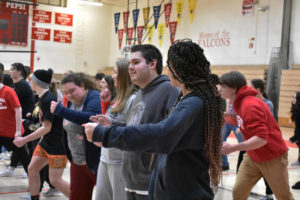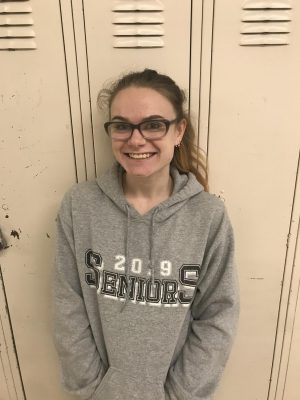District special education approach being revisited
Created using Canva.com
January 15, 2019
The Davenport School District has recently been under scrutiny by the state due to failures in the current special education programs provided. The district has received several audits across 2018, multiple relating to the special education department, namely being out of compliance with disproportionality of identification and placement decisions. The district is currently trying to find ways of dealing with these audits.
Major changes are being made to the way the district handles special education, and treatment of individual students, namely taking a less reactive approach and only waiting for students to be recognized by teachers
“We’re going to be more proactive,” interim superintendent TJ Schneckloth said. “We’re going to recognize when students are falling behind and we’ll do as much as we have to to get them back on track”
Many involved see the changes as a necessary step forward given previous mistakes. The current structure of Davenport’s special education system is built on Individual Education Programs (IEP), programs designed to assist students at the individual level. In theory, this allows for progression at the students’ level so as to avoid overwhelming or under preparing them. Students with IEPs are often enrolled in general education classes although they are given necessary assistance and differentiated opportunities when needed.
Schneckloth admits these faculty members have not been used properly by the district due to things like failure to implement proper individualization and failure to assess students properly, as well as issues with laws surrounding Title 20.
“Any state educational agency, state agency, or local educational agency that receives assistance under this subchapter shall establish and maintain procedures in accordance with this section to ensure that children with disabilities and their parents are guaranteed procedural safeguards with respect to the provision of a free appropriate public education by such agencies,” the audit-related section of Title 20 states.
The issue lies mainly in the failure to give proper write ups, notifications of what needs to be done as part of a specific IEP’s plan and build around that. The district was failing to properly adapt around students needs and proper write ups. However, Schneckloth primarily blames the district as opposed to the IEPs.
“The fault was not with the IEPs,” Schneckloth said. “The issue was with us and our inability to properly individualize.”
In an attempt to help diminish the issues of the predetermined practices of IEPs, certain students are entitled to compensatory education. This system has helped address certain student’s needs further.
“We’re allowing students to get help outside of class,” associate principal Charlie Driscoll said. “This way we can help further identify kid’s needs as we rewrite.”
These audits could be seen as marks on the district’s record. But some, like special education department head Michelle Martens see these audits as a call for necessary improvement.
“I think there’s a lot of positives,” Martens said. “Each kid is now being identified and individualized. We’re putting the I back in IEP.”
Driscoll also sees optimism in the changes directed towards the way IEPs are being used within the district.
“We are now rewriting each IEP so each kid has one suited to their own needs,” Driscoll said.
Aside from IEP issues,the district has also faced issues with disproportionality. As the state looked at the demographics of students identified as needing special education, a larger than average number of them belonged to a racial minority.
The burden lies on the district to now look at identified students and figure out how they were put in that position
“We now have to look at our students of different races and find out what the issue is,” Martens said. “All the state did was look solely at racial demographics. It’s up to us, the school district to find out why the students are there. Is it from their environment, or is it because of a disability?
The issue of disproportionality has been an issue that the school board has noted previously but had not directly acknowledged.
“We’ve had some long standing issues with disproportionality,” Schneckloth said. “This audit was kind of the outcome of that and we’re doing our best to fix it.”
In a somewhat similar vein, the way suspensions have been used have prompted necessary evidence from the special education department to provide evidence of manifest determination meetings.
Martens explains that a manifest determination meeting is held after suspensions of special education students and is a discussion of how disability may have been a part of the student’s decision making in doing whatever it was that got them suspended.
“It’s a way of preventing incidents in the future,” Martens said. “If it was a result of a disability then we can begin taking measures to prevent similar incidents in the future.”
As for disproportionate suspensions as a whole, the district has taken efforts to make sure there are less cultural barriers with the help of program directors like Sharroky Hollie, an educator out to increase cultural responsiveness.
“He helped us, the whole district,” Driscoll said. “So hopefully we can work with students of different cultures and fit their needs at school.”
Even with the issues the district is facing thanks to these audits, both Martens and Schneckloth remain optimistic and excited for the change to come.
“The plan for the district is to become more proactive, rather than reactive,” Schneckloth said. “If we can do that, then we’re doing something right and we can help prevent issues like this in the future.”
The change to a more proactive style of special education means pushing everyone as much as necessary. This also gives IEPs more room to do their job as individual assistants, rather than subject to cookie cutter molds that are one size fits all.
There is improvement to come for the program thanks to the current stress.
”In the end, we’re striving to do better,” Martens said. “We all could do better. I can do my job better, and so can everyone else. That’s why I think this situation isn’t entirely bad because we will improve as a result.”






